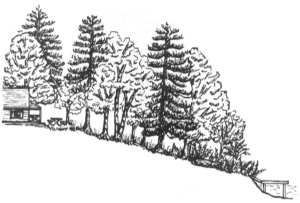Vegetative clearing standards
 PROTECT THE VEGETATION TO PROTECT YOUR LAKE – The protection of vegetative buffer areas along lakes, streams, and wetlands is essential to maintaining water quality. Here are some minimum standards required by state law; however, some towns have stricter standards. If you notice someone violating these important standards, call your town’s Code Officer or LEA. The following standards apply within the buffer area (within 100 feet of the normal high water mark of all lakes and rivers, within 75 feet of the normal high water mark of zoned streams (some towns require 100 feet), and within 75 feet of the upland edge of zoned wetlands. See your town’s official Shoreland Zoning Map for exact boundaries. Here are the universal rules:
PROTECT THE VEGETATION TO PROTECT YOUR LAKE – The protection of vegetative buffer areas along lakes, streams, and wetlands is essential to maintaining water quality. Here are some minimum standards required by state law; however, some towns have stricter standards. If you notice someone violating these important standards, call your town’s Code Officer or LEA. The following standards apply within the buffer area (within 100 feet of the normal high water mark of all lakes and rivers, within 75 feet of the normal high water mark of zoned streams (some towns require 100 feet), and within 75 feet of the upland edge of zoned wetlands. See your town’s official Shoreland Zoning Map for exact boundaries. Here are the universal rules:
- One winding footpath of no more than six feet in width is allowed for each lot or for each 200 feet of shoreline frontage.
- New structures are not allowed within the buffer area. This prohibition includes storage buildings, boat houses, patios, decks, tents, and any portion of a dock extending above the normal high water line.
- All existing vegetation under 3 feet in height cannot be removed, killed, or otherwise damaged.
- In the off-season, docks should be stacked on the footpath to avoid damage to buffer vegetation.
- Fill cannot be brought into an undisturbed buffer except for path construction or to re-vegetate bare ground as part of an approved re-vegetation plan.
- The creation of cleared openings greater than 250 square feet in the canopy within 100 feet of the water is prohibited and an even forest canopy must be maintained.
- Trees can be limbed up the bottom third of their height.
- Openings or view corridors in existence prior to January 1, 1989 can be maintained but not enlarged.
- Footpaths must be winding in order to provide opportunities for runoff to disperse into the buffer. They cannot be constructed so as to create a view corridor.
- Openings that have “closed” with growth of woody vegetation cannot be “re-opened”.
- “Grandfathered” buildings within the buffer may be expanded in a limited way. The expansions can be no closer to the waterbody than the original structure, and the size of the total expansion is also restricted. Check your town’s shoreland zoning ordinance for specific provisions.
- Before any construction begins, pre-construction photos should be taken. Erosion control must be properly installed at the upland extent of the buffer area, below any construction, and along the contour.
- No disturbance of the ground cover (including the duff and leaf layer) or vegetation shall be caused within the buffer or between the lake and a grandfathered or new structure. Equipment movement and excavation disturbance must be carefully controlled to avoid any impact on the buffer. For example, it is not legal to locate a foundation at the buffer limit if that placement will cause any disturbance within the buffer.
 PROTECT THE VEGETATION TO PROTECT YOUR LAKE – The protection of vegetative buffer areas along lakes, streams, and wetlands is essential to maintaining water quality. Here are some minimum standards required by state law; however, some towns have stricter standards. If you notice someone violating these important standards, call your town’s Code Officer or LEA. The following standards apply within the buffer area (within 100 feet of the normal high water mark of all lakes and rivers, within 75 feet of the normal high water mark of zoned streams (some towns require 100 feet), and within 75 feet of the upland edge of zoned wetlands. See your town’s official Shoreland Zoning Map for exact boundaries. Here are the universal rules:
PROTECT THE VEGETATION TO PROTECT YOUR LAKE – The protection of vegetative buffer areas along lakes, streams, and wetlands is essential to maintaining water quality. Here are some minimum standards required by state law; however, some towns have stricter standards. If you notice someone violating these important standards, call your town’s Code Officer or LEA. The following standards apply within the buffer area (within 100 feet of the normal high water mark of all lakes and rivers, within 75 feet of the normal high water mark of zoned streams (some towns require 100 feet), and within 75 feet of the upland edge of zoned wetlands. See your town’s official Shoreland Zoning Map for exact boundaries. Here are the universal rules: